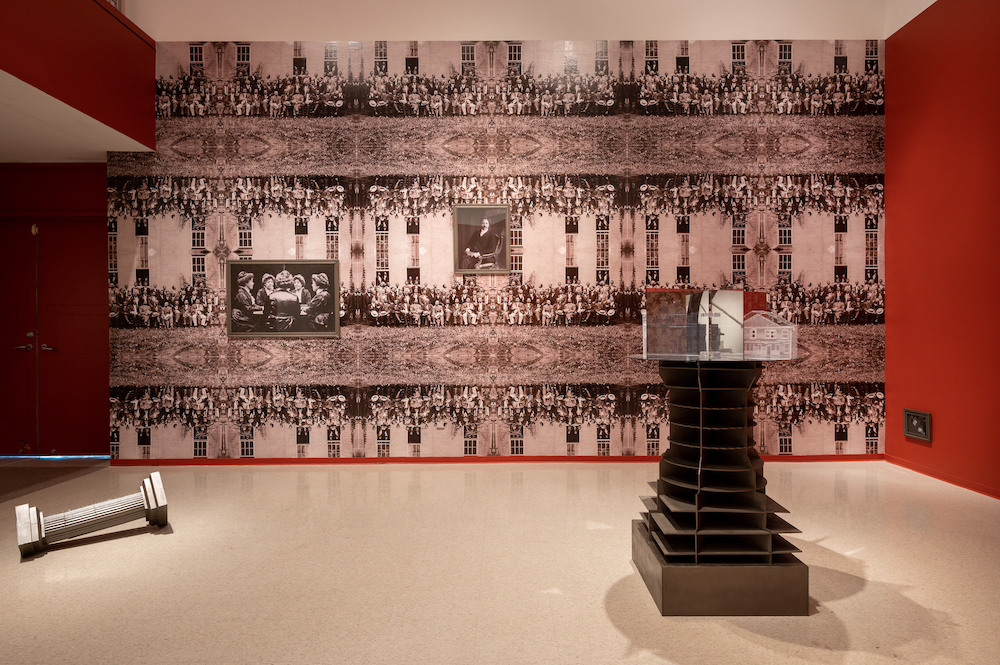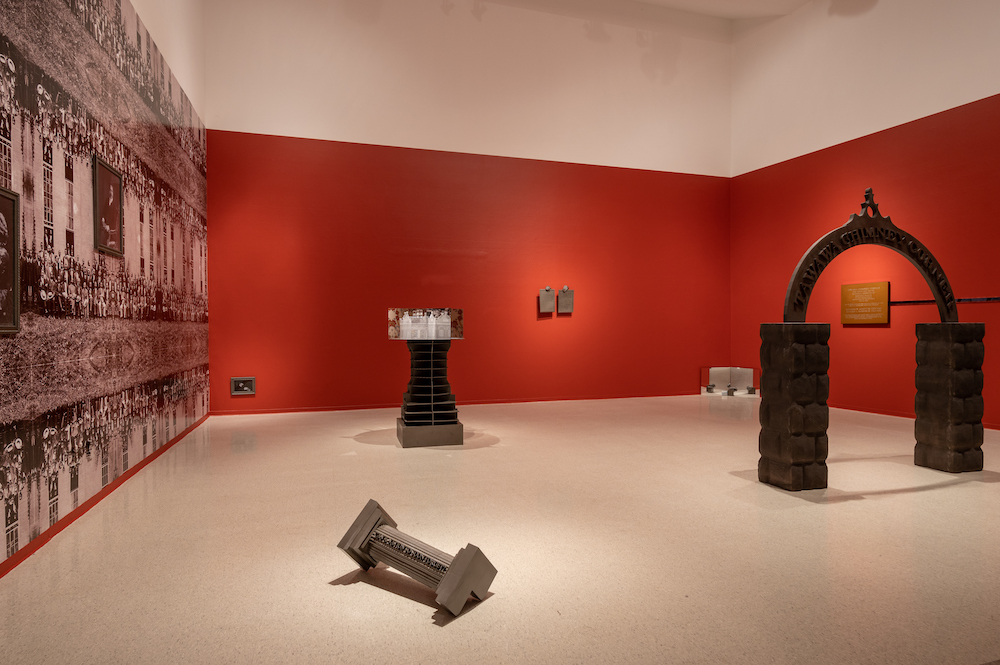When stepping into Britt Ransom’s solo exhibition, you face an archway. This reproduction, created with 3D scans, prints and a CNC machine, revives a signature piece of the Tawawa Chimney Corner house in Wilberforce, Ohio. Today, only the arch’s stone pillars remain, but Ransom dug into her family archives to find a photograph suitable for reference. In “Arise and Seek,” Ransom amplifies her ancestors’ role in the civil rights movement, commemorating their activism with architectural forms, sculptures, photographs and ephemera.
On the second floor of the gallery, a large timeline stretches across the mezzanine, thoroughly detailing the legacies of Ransom’s great-great–grandparents, Bishop Reverdy C. Ransom and Emma Ransom, who are central to the exhibition. In the early 20th century, they were instrumental in advancing the civil rights movement; Reverdy, with famous activists such as W.E.B. Du Bois, co-founded the Niagara Movement, the precursor to the NAACP. Emma championed suffrage for Black women. The two spent many years residing in the Tawawa Chimney Corner house, where they held dialogues with prominent figures such as Du Bois, Ida B. Wells, Jane Addams and President Franklin D. Roosevelt.
In 2020, the house was added to the National Register of Historic Places, despite its deteriorated condition. The paint on its white farmhouse siding is chipped away, the wood is rotting and windows are boarded up. Ransom, with the help of her relatives, has acquired funding so they can repair the exterior. In the meantime, she can prototype its restoration and transform it into contemporary art.
Ransom utilizes digital fabrication techniques like laser cutting, photogrammetry, 3D modeling and printing, and computer-controlled milling to make detailed reproductions of living organisms. “Arise and Seek” is her first foray into building monuments, and she worked collaboratively with makerspaces, historians and archives across the country. They helped Ransom reproduce the Tawawa Chimney Corner house arch with sturdy recycled foam and employed digital-surface design methods to reconstruct the house’s old wallpaper, which blankets one wall. A column was sculpted from 3D prints and resin casts of Ransom’s hand-grip laser-cut steel plaques, which memorialize Reverdy’s speeches.
Ransom was not the first family member to test cutting-edge machines. An archival print, Emma Ransom Multigraph (all works 2022), shows many reflections of Emma’s body in a carousel of mirrors. Taken in the 1890s, the multigraph was a unique composition that embraced emerging technology, the camera and lens. Ransom repeats this technique multiple times. With Layering Sites, acrylic scale models of the Tawawa Chimney Corner house and abolitionist John Brown’s fort in Harpers Ferry, West Virginia, are made infinite. In one corner, a section from the column Can a Nation So Soon Forget?—held by one of Ransom’s resin hands—blossoms five times in mirrored reflections. Both pieces fold the viewers into the work, urging them to consider their place in civil rights history.
Much of the show mediates upon whose stories are told in monuments, and Ransom tries to fit her own family’s history into the gaps left by federal preservation. She gives prominence to Brown, who attempted to spark a slave rebellion in the pre–Civil War era. He was a hero to many civil rights leaders, and Reverdy channeled Brown’s tenacity in his speech “The Spirit of John Brown,” which he delivered at the second meeting of the Niagara Movement.
There are many monuments dedicated to Brown across the country, including the fort in Harpers Ferry, which are marked by institutional bronze plaques. One of these plaques, which Ransom has recreated with the work John Brown Fort Site Reconstruction, was funded by the NAACP. Ransom mounts a steel rod to connect this plaque to another replica, Tawawa Chimney Corner Plaque Reconstruction, to emphasize the connection between her ancestors and Brown’s fame. It’s difficult to measure just one person’s impact on any historical movement, but Ransom’s pieces suggest that Reverdy and Emma’s legacies should be treated with equal importance.

Installation views of “Britt Ransom: Arise and Seek,” January 28—March 25, 2023, at Pitzer College Art Galleries. Photos by Christopher Wormald.
Another set of pieces, Arise and Seek (Series of 2), takes excerpts from two of Reverdy’s speeches made in Boston, A Philippic on the Atlanta Riot (1906) and On John Greenleaf Whittier, Plea for Equality, Centennial Oration (1907), and transcribes them on bas-relief to make them appear as historic plaques. Unlike many of the reproductions in the show, these monuments do not actually exist outside of the gallery, but Ransom has imitated the aesthetic to anchor Reverdy’s place in history. Both are adorned with Ransom’s resin hands. She literally carries Reverdy’s words into the present, fulfilling her responsibility of sharing her family’s story.
Even when people like Reverdy and Emma have been formally documented, their stories are still at a high risk of being forgotten. Many will never have their stories told at all. This is exemplified in another wallpaper Ransom created, Harpers Ferry (Wallpaper), which utilizes an image of those who gathered for the second Niagara Movement in 1906. This image is also adhered to informational markers at Harpers Ferry National Park. It shows 46 men, but only a few of their names are recorded on the monuments. Some men stick their head out of open windows, unable to fit into frame, and one man’s body, seated at the edge of his row, has been cut in half by the camera, making him anonymous. Ransom’s wallpaper uses a mirroring technique to make the photo infinitely expand, and it incidentally reflects this attendant’s half-captured profile, reconstructing his face in a distorted format. While his name remains unknown, Ransom has restored his place in the movement.
To be represented in history takes a lot of money and influence. Ransom’s National Parks Service grant to restore the Tawawa Chimney Corner house will prolong its life but won’t be enough to save it permanently. Family members need to find more support before they can realize their dream of turning the house into a museum and cultural center with a permanent library, an art collection by significant Black artists, and a community meeting space.
Before the home can be fully renovated, Ransom must recapture the public eye, commemorating Reverdy’s and Emma’s dedication to Black equality and suffrage. “Arise and Seek” is just another chapter in a long story that will continue through art, monuments, and activism.

Installation views of “Britt Ransom: Arise and Seek,” January 28—March 25, 2023, at Pitzer College Art Galleries. Photos by Christopher Wormald.


